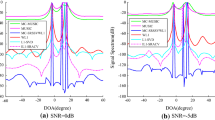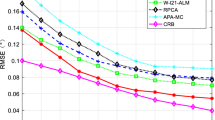Abstract
In the imperfect communication environment, the array received signal may have missing data, which could suffer from the direction-of-arrival (DOA) estimation performance deterioration. To this end, the matrix completion method is usually used for recovering the missing data of received signal to improve the DOA estimation accuracy. In this paper, a matrix completion DOA estimation algorithm is proposed based on UV decomposition. Firstly, the array received signal recovery problem is transformed into a matrix completion problem. On this basis, the UV decomposition of the signal is introduced into the matrix completion model, which avoids the singular value decomposition of kernel norm optimization and reduces the computational complexity. In addition, a residual regular term is utilized in the proposed algorithm to reduce the data deviation caused by matrix decomposition. Then, the received signal of the array to be recovered is solved by the alternating direction multiplier method (ADMM) algorithm. Finally, the multiple signal classification (MUSIC) algorithm is used to estimate the DOA of recovered array signal. Simulation results indicate that the proposed algorithm can better recover data to perform DOA estimation with the low computational complexity, and is superior to existing DOA estimation algorithms based on matrix completion.






Similar content being viewed by others
References
Shi, J., Hu, G., Zhang, X., & Sun, F. (2019). Sparsity-based doa estimation of coherent and uncorrelated targets with flexible mimo radar. IEEE Transactions on Vehicular Technology, 68(6), 5835–5848.
Wan, L., Liu, K., Liang, Y.-C., & Zhu, T. (2021). Doa and polarization estimation for non-circular signals in 3-d millimeter wave polarized massive mimo systems. IEEE Transactions on Wireless Communications, 20(5), 3152–3167.
Schmidt, R. (1986). Multiple emitter location and signal parameter estimation. IEEE Transactions on Antennas and Propagation, 34(3), 276–280.
Roy, R., & Kailath, T. (1989). Esprit-estimation of signal parameters via rotational invariance techniques. IEEE Transactions on acoustics, speech, and signal processing, 37(7), 984–995.
Bresler, Y. (1988). Maximum likelihood estimation of a linearly structured covariance with application to antenna array processing. In: Fourth Annual ASSP Workshop on Spectrum Estimation and Modeling, pp. 172–175. IEEE
Ge, C., He, L., Zhou, M.-J., Lin, X.-P., & Zhang, X.-F. (2018). Two-dimensional doa estimation with partial damaged sensors in rectangular array based on tensor reconstruction. In: 2018 4th Annual International Conference on Network and Information Systems for Computers (ICNISC), pp. 299–306. IEEE
Setayesh, A., Yazdian, E., & Malek-Mohammadi, M. (2019). Direction of arrival estimation with missing data via matrix completion. Signal, Image and Video Processing, 13(7), 1451–1459.
Mohajer, A., Sorouri, F., Mirzaei, A., Ziaeddini, A., Rad, K. J., & Bavaghar, M. (2022). Energy-aware hierarchical resource management and backhaul traffic optimization in heterogeneous cellular networks. IEEE Systems Journal, 16(4), 5188–5199.
Dong, S., Zhan, J., Hu, W., Mohajer, A., Bavaghar, M., & Mirzaei, A. (2023). Energy-efficient hierarchical resource allocation in uplink-downlink decoupled noma hetnets. IEEE Transactions on Network and Service Management
Mohajer, A., Daliri, M. S., Mirzaei, A., Ziaeddini, A., Nabipour, M., & Bavaghar, M. (2022). Heterogeneous computational resource allocation for noma: Toward green mobile edge-computing systems. IEEE Transactions on Services Computing, 16(2), 1225–1238.
Cai, J.-F., Candès, E. J., & Shen, Z. (2010). A singular value thresholding algorithm for matrix completion. SIAM Journal on optimization, 20(4), 1956–1982.
Lin, Z., Ganesh, A., Wright, J., Wu, L., Chen, M., & Ma, Y. (2009). Fast convex optimization algorithms for exact recovery of a corrupted low-rank matrix. Coordinated Science Laboratory Report no. UILU-ENG-09-2214, DC-246
Chen, Y., Xu, Y., & Li, R. (2016). An alm matrix completion algorithm for recovering weather monitoring data. In: 2016 IEEE Symposium on Computers and Communication (ISCC), pp. 988–995. IEEE
Wang, X., Zhu, Y., Huang, M., Wang, J., Wan, L., & Bi, G. (2019). Unitary matrix completion-based doa estimation of noncircular signals in nonuniform noise. IEEE Access, 7, 73719–73728.
Fei, Y., Cao, H., Wu, Y., Chen, X., & Chen, L. (2021). Doa estimation in non-uniform noise using matrix completion via alternating projection. IEEE Open Journal of Antennas and Propagation, 2, 281–285.
Jalal, B., Elnahas, O., & Quan, Z. (2022). Efficient doa estimation under partially impaired antenna array elements. IEEE Transactions on Vehicular Technology, 71(7), 7991–7996.
Chen, J., Gao, W., & Wei, K. (2021). Exact matrix completion based on low rank hankel structure in the fourier domain. Applied and Computational Harmonic Analysis, 55, 149–184.
Mazumder, R., Hastie, T., & Tibshirani, R. (2010). Spectral regularization algorithms for learning large incomplete matrices. The Journal of Machine Learning Research, 11, 2287–2322.
Bokaei, M., Razavikia, S., Amini, A., & Rini, S. (2022). Single-snapshot doa estimation via weighted hankel-structured matrix completion. In: 2022 30th European Signal Processing Conference (EUSIPCO), pp. 1756–1760. IEEE
Jiang, G., Mao, X.-P., & Liu, Y.-T. (2020). Underdetermined doa estimation via covariance matrix completion for nested sparse circular array in nonuniform noise. IEEE Signal Processing Letters, 27, 1824–1828.
Zhao, J., Liang, Y., Yi, S., Shen, Q., & Cao, X. (2023). Improving generalization of double low-rank representation using schatten-p norm. Pattern Recognition, 138, 109352.
Acknowledgements
This work was supported by the National Natural Science Foundation of China (Grant No. 61971117) the Natural Science Foundation of Hebei Province (Grant No. F2024501005) and the \(\mathrm {S \& T }\) Program of Hebei (No. 22377717D).
Author information
Authors and Affiliations
Corresponding authors
Additional information
Publisher's Note
Springer Nature remains neutral with regard to jurisdictional claims in published maps and institutional affiliations.
Rights and permissions
Springer Nature or its licensor (e.g. a society or other partner) holds exclusive rights to this article under a publishing agreement with the author(s) or other rightsholder(s); author self-archiving of the accepted manuscript version of this article is solely governed by the terms of such publishing agreement and applicable law.
About this article
Cite this article
Liu, F., Meng, G., Zhang, B. et al. Doa estimation algorithm based on UV decomposition matrix completion. Wireless Netw 31, 2317–2326 (2025). https://doi.org/10.1007/s11276-024-03883-2
Accepted:
Published:
Issue Date:
DOI: https://doi.org/10.1007/s11276-024-03883-2




